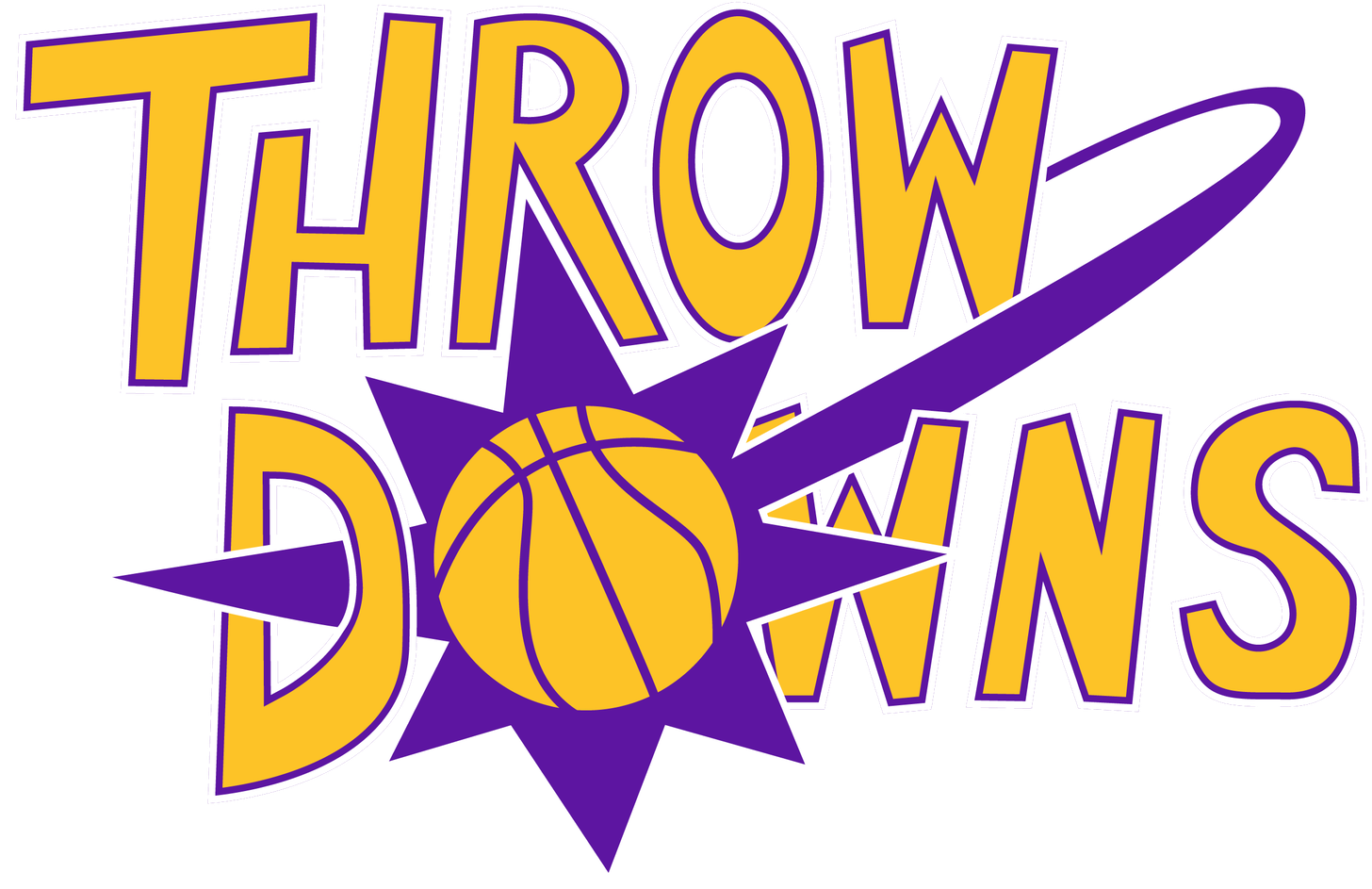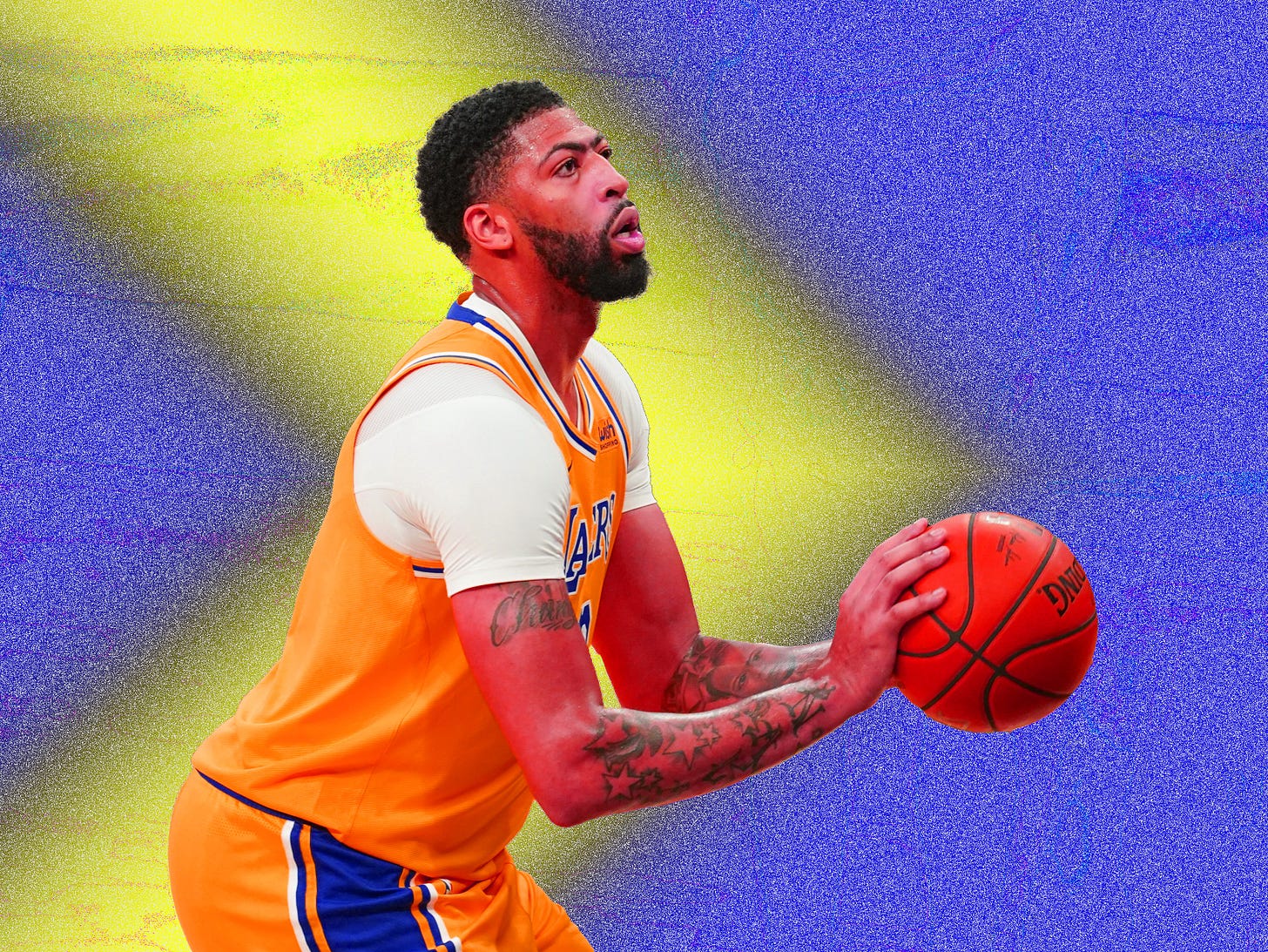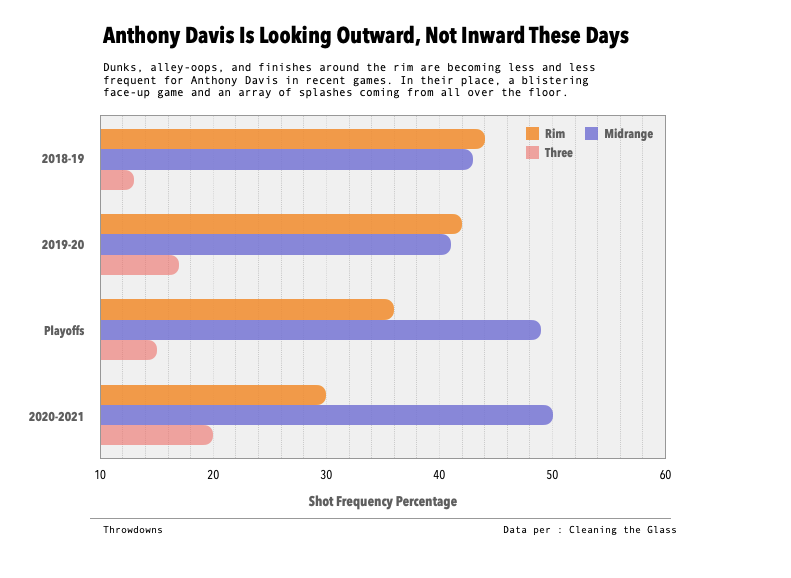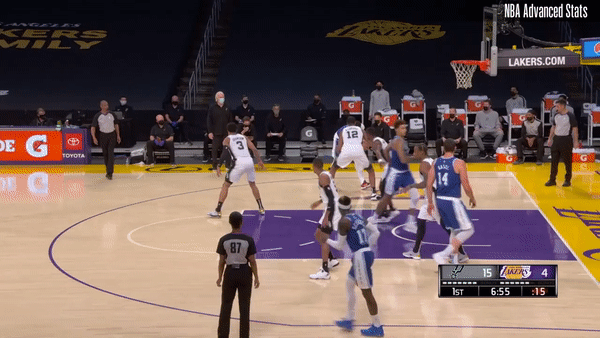Why Anthony Davis is Attacking the Rim Less
Anthony Davis' evolution as a jump-shooter is a scary proposition for the rest of the league, but less so if that's all he does.
Welcome to issue #26 of Throwdowns.
The Lakers are only ten games into their season, and because of that, it is difficult to pick up on any trends that could potentially be lasting.
They have also approached the early part of their schedule with let’s just call suboptimal effort. Which makes analyzing them even more difficult.
But, there is one player, and one specific tendency, that has carried over the course of a year worth discussing in today’s edition of…
The scene begins in a familiar way. Anthony Davis, on the left block, the ball in his hands against a defender on an island who hunkers down trying his best not to flinch. Behind them, the black hole that is the San Antonio Spurs’ restricted area.
The city, the opposition and the rest of the moving parts don’t necessarily matter, because the outcome is one we’ve seen countless times before.
Davis typically blows by his obstacle with one of his many — and simply unfair — go-to moves, then detonation happens. A sonic boom. Two points, a roar, and back down the floor everyone goes.
But this time, that’s not what happened. On this possession, Davis squares up Jakob Poeltl with an in-between dribble and instead of attacking forward, he steps back. His jumper bangs off the cylinder and the loose ball is swatted out of bounds. The defense exhales at the anti-climatic ending.
The above scenario is one that has taken place more and more frequently since Davis joined the Lakers. The aforementioned explosions at the rim still happen, but have begun taking a backseat to jump shots.
Glimpses of his approach shifting started last season, when Davis steadily steered further away from the basket and bought up real-estate at the elbow.
There were of course, legitimate basketball reasons for this. His frontcourt mates, JaVale McGee and Dwight Howard, were in no way floor spacers individually, so this meant Davis had to slot in and fill that role.
Davis’ long-time reticence to playing center also didn’t help matters in terms of creating more roll and dump-off opportunities for himself. And this is a preference the Lakers will gladly oblige, especially given the gleaming new hardware their strategy of mostly saving his center minutes for the playoffs helped deliver this past October.
It was in the bubble, however, where Davis’ transformation really began to blossom. He not only began shooting more midrange jumpers than ever before, but also started swishing them at an absurd clip. Davis would go on to hit 49% of his attempts from the midrange in the postseason, and shot 38% from behind the arc during the Lakers’ championship run.
“If he makes those he’s impossible to guard,” said Lakers head coach Frank Vogel when recently asked about his star’s refined shooting repertoire.
Daniel Dunn-USA TODAY Sports | Throwdowns Illustration
Similar to building a mechanized version of Godzilla, or concocting a Jason Voorhees cyborg, the concept of Davis with a jump-shot simply felt like overkill. An unstoppable force that can’t be plausibly defeated by mere mortals.
But that danger only exists if this new weapon became a tool, and not the entire toolbox. The Lakers are only ten games into their new season, but this trend ofDavis settling for shots from the perimeter has only become more lopsided.
As the graph above indicates, exactly half of Davis’ shots this season have come from the midrange, while just 30% have come at the rim. Both would be a career high and low, respectively.
There was probably no better example of this change in Davis’ shot profile than during his two outings against the Memphis Grizzlies last week, where he attempted just three shots at the rim combined.
So why the uptick in face-up jumpers, and decrease in finishes around the rim? The answer is multi-faceted.
If last season’s change in shot profile was correlated to the lack of shooting ability in the frontcourt, the arrival of Marc Gasol should in theory have created more breathing room for Davis to operate, not less. But instead, Davis is shooting more jumpers from midrange and the 3-point line.
This is not something — at least outwardly —Vogel has batted an eye towards. It actually sounds like the trend is by design.
“He’s shooting the ball extremely well all over the floor for us this year. So if we’re going to play most of our minutes — which we are right now — with him at the four, it’s important to be a floor spacer. And carry that threat in that type of role,” Vogel said.
In most possessions where Davis and Gasol have shared the floor this year, the role Vogel envisioned for Davis to fill has transpired, and is easily seen through his shot profile. The coaching staff has even said on multiple occasions they want Davis to shoot at least five 3-point attempts per game.
And although he’s a capable shooting threat himself (38% from three last season), Gasol has mostly occupied the dunker spot left by the previous frontcourt rather than park behind the 3-point line like many envisioned when the team signed the veteran big man.
It’s worth noting that Davis has continued his hot shooting from the perimeter this year — he’s shooting 46% on his midrange attempts and 40% from three, both would be regular season career highs — but the spatial positioning and driving lanes continue to be crammed when it comes to his own opportunities at the basket.
But while the team would never admit it, Davis’ trigger-happy approach could also simply be a vehicle for body preservation. He has already missed a few games this year due to injury, including the team’s most recent contest against the Bulls.
And given that they’re going through the shortest turnaround in league history after their lengthy playoff run, Davis avoiding the paint and the dangers that come with attacking the rim and leaving his feet on a regular basis could be a mutually beneficial decision.
Whatever the reason, however, if it seems like Davis is going to the rim less, it’s because he is. There is his aforementioned career low shot frequency at the rim, but also that he’s averaging roughly one less dunk a game, and a career low in free-throw attempts (3.9) per contest.
Collectively, the team has also not exactly raced out of the gates this season in terms of energy exertion, and the decrease in shots at the rim is not solely a Davis occurrence, but a team-wide one, as the Lakers are down 5.4% as a whole in their shots at the rim. And if that’s why Davis is attacking the rack less, it is difficult to find too much fault in this line of thinking given such context.
However, there are ways the team could safely and strategically find better routes to get Davis going toward the rim more often, which will in turn only make his newfound shooting ability more deadly given that defenses will have to sink back to protect the drive. This could prove especially valuable in the playoffs, where these exact shots readily become more available and necessary as bailout options for an offense.
Above, the Lakers present Davis an opportunity to isolate against LaMarcus Aldridge in the post. LeBron James even makes the concerted effort to empty out the vicinity to create more operating room. But the off-ball movement gums up any potential driving opportunity.
Contrast that with the possession below, where Kyle Kuzma quickly removes himself from the paint, which allows Davis to get to the rim without fear of the help-defense.
Finding the proper equilibrium when infusing Davis’ face-up and perimeter game with his stellar ability to finish around the rim is something he and the team will have to navigate this year if they hope to repeat as champions. And even if it looks different, or is slightly less effective, Davis turning the midrange jumper into a weapon makes him shooting a few more to lower his overall exertion a forgivable sin.
“He’s been on fire shooting those shots,” Vogel said. “So if he had an off night… it’s not a big concern of mine. He has a good feel about the balance that he wants to have.”
And when push comes to shove, the Lakers do ultimately hold the trump card of playing Davis at center, an ace in the hole that has shown to be devastatingly effective when they need it most. On Thursday night, the team and Davis reminded the world of this when Gasol was cemented to the bench due to foul trouble.
With an interior to himself, and sitting as the sole target for his team’s playmaking, the 27-year-old did exactly what he has always done — dominate. Davis attempted 11 shots at the rim, converted 10, but was still so frustrated by the loss that he kicked over a drink cart and then described his team’s effort on defense as “shit” postgame.
It was a little reminder that, both on and off the court, the fiery competitor Lakers fans grew to love in the postseason was still kicking. He may be taking things easier now, but he’s still in there, ready to get physical when the game isn’t going his way.
So whether he is attacking the rim or ripping the nylon from 14 feet out, when Davis gets that defender on an island — and their feet begin to tremble — the route he takes now may be different, but that momentary sense of anticipation of what comes next will always still be the same. And if he keeps shooting this well, the end result will be just as demoralizing.
Harrison Faigen also contributed to this article, which was co-published on Silver Screen and Roll.com.
Thank you for reading. Throwdowns will continue to be free, but If you enjoyed this or any other post in the archive, donations are highly appreciated via my Venmo (AlexRegla). No amount is too small, and it will go a long way in keeping this newsletter going.








